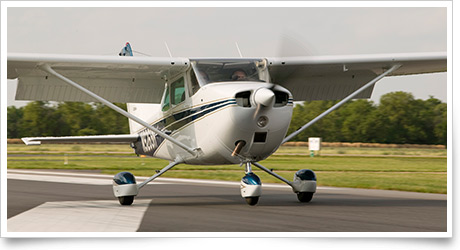| The following stories from the Feb. 3, 2012, edition of AOPA ePilot were provided to AOPA members who expressed an interest in the particular subject areas. Any AOPA member can receive information tailored to their areas of interest by updating their preferences online |
training tipsNever give up There's a lot to learn from those veteran pilots. A common error of pilot trainees is that they tend to cease flying as soon as the wheels touch the ground on landing. Typically the trainee immediately relaxes all back-pressure on the yoke; some even push the nose forward for no reason in response to a sort of mental letdown, especially after a challenging approach. But that's exactly the wrong thing to do when the wheels are still rolling. The most benign result you can hope for of "giving up" by letting the nose come down prematurely is delayed deceleration and a longer than necessary ground roll. More troublesome is when the error induces wheelbarrowing, compromising braking and steering—bad news in a crosswind. But by simply maintaining the back-pressure after the main wheels touch, aerodynamic braking can help you slow down. Then as airflow over control surfaces decays, the nosewheel will lower itself smoothly onto the runway, even with continued full aft elevator, making the whole operation look and feel like a smooth piece of work. Even when special scenarios present an exception calling for the pilot to positively lower the nosewheel to the runway, a fine touch is still required, usually combined with other elements of technique. Consider this portion of the short-field landing technique given in a Cessna 152 pilot's operating handbook: "Immediately after touchdown, lower the nosewheel and apply heavy braking as required." Then there's the more hybridized technique recommended for a Piper PA-28-161 airplane that recommends holding the nosewheel off as long as possible and then gently lowering it and applying brakes as the aircraft slows. Whatever aircraft you fly and whichever landing technique applies to your next landing, don't leave such matters as deciding when the nosewheel should contact the runway to chance. By sharpening your consciousness of this basic element of performing landings, you may take your technique to the next level. training productsReturn to Flying VFR KitIf you got your certificate and then had to stop flying—for whatever reason—you may be reluctant to think about the work involved in getting back up to speed. The King Schools Return to Flying VFR Kit is designed to quickly restore your pilot knowledge so that you can be well prepared to act as pilot in command. The kit features a selection of DVDs and programs for the personal computer, covering topics that include VFR cross-country flying, navigation, airspace, weather, night flying, emergencies, communications, airport signs and markings, and VFR regulations. Also included are a VFR/IFR cockpit card and a flight planning organizer pad. The collection comes in a burgundy bag and sells for $299. Order online or call 800/854-1001.
Note: Products listed have not been evaluated by ePilot editors unless otherwise noted. AOPA assumes no responsibility for products or services listed or for claims or actions by manufacturers or vendors. final examQuestion: What is meant by the term "Mode C veil"?
Answer: "Mode C veil" refers to an area around a Class B airport in which a Mode C transponder is required. According to Federal Aviation Regulation 91.215(b)(2), "This requirement (for Mode C transponders) applies to all aircraft in all airspace within 30 nautical miles of an airport listed in Appendix D, section 1 of this part from the surface upward to 10,000 feet msl (mean sea level)." An exception found in FAR 91.215(b)(3) includes, among others, any aircraft that was not originally certificated with an engine-driven electrical system. For more information on Mode C and other airspace, take the Air Safety Institute's online course Know Before You Go: Navigating Today's Airspace .
Got a question for our technical services staff? E-mail [email protected] or call the Pilot Information Center, 800/872-2672. Don’t forget the online archive of “Final Exam” questions and answers, searchable by keyword or topic. |
 You've heard it said of certain airplanes that they must be flown every second until they are safely shut down on the ramp. It's easy to recognize pilots who have flown that kind of machine because they never lose the paying-attention-to-details habit, even when flying airplanes with milder reputations.
You've heard it said of certain airplanes that they must be flown every second until they are safely shut down on the ramp. It's easy to recognize pilots who have flown that kind of machine because they never lose the paying-attention-to-details habit, even when flying airplanes with milder reputations.

